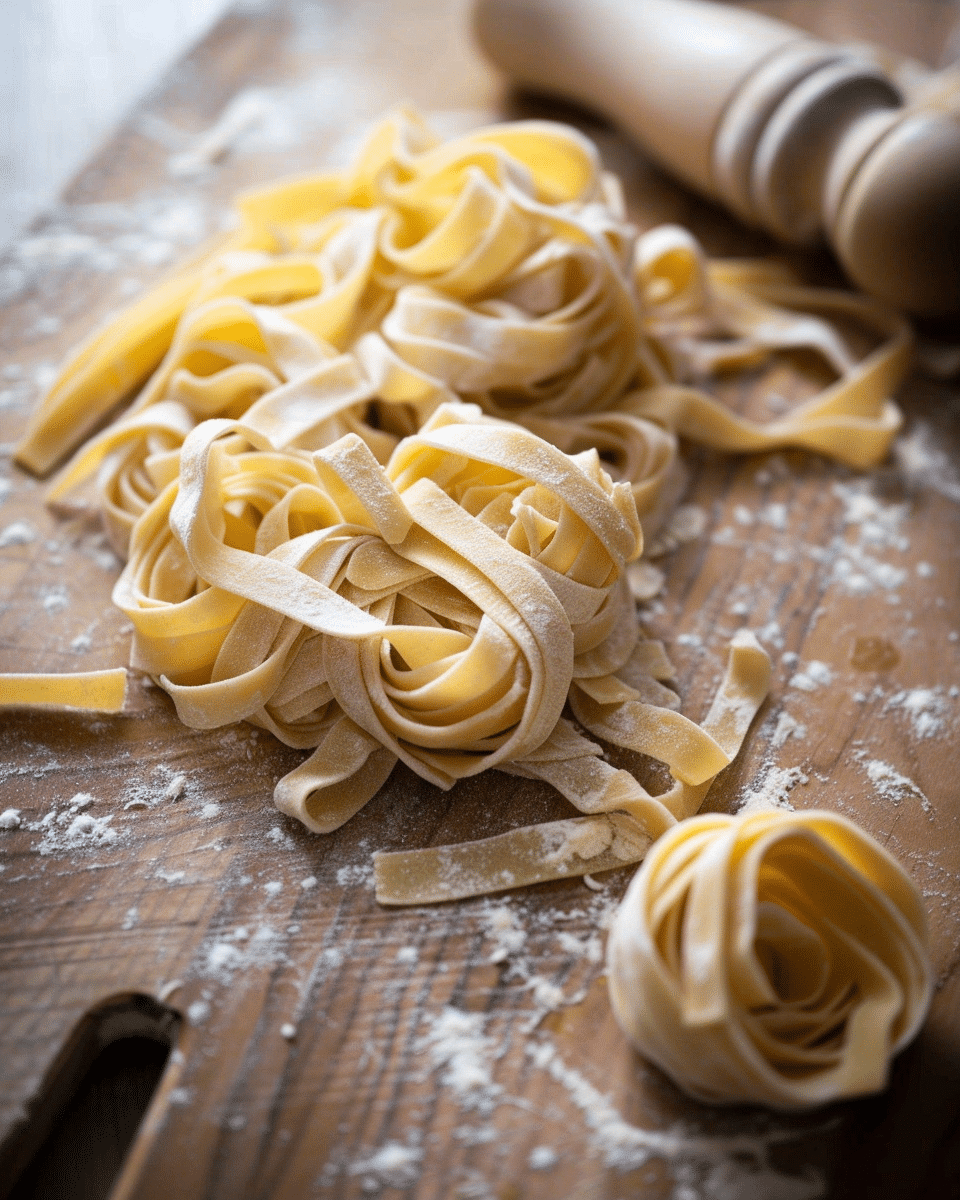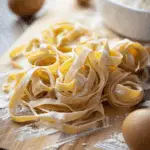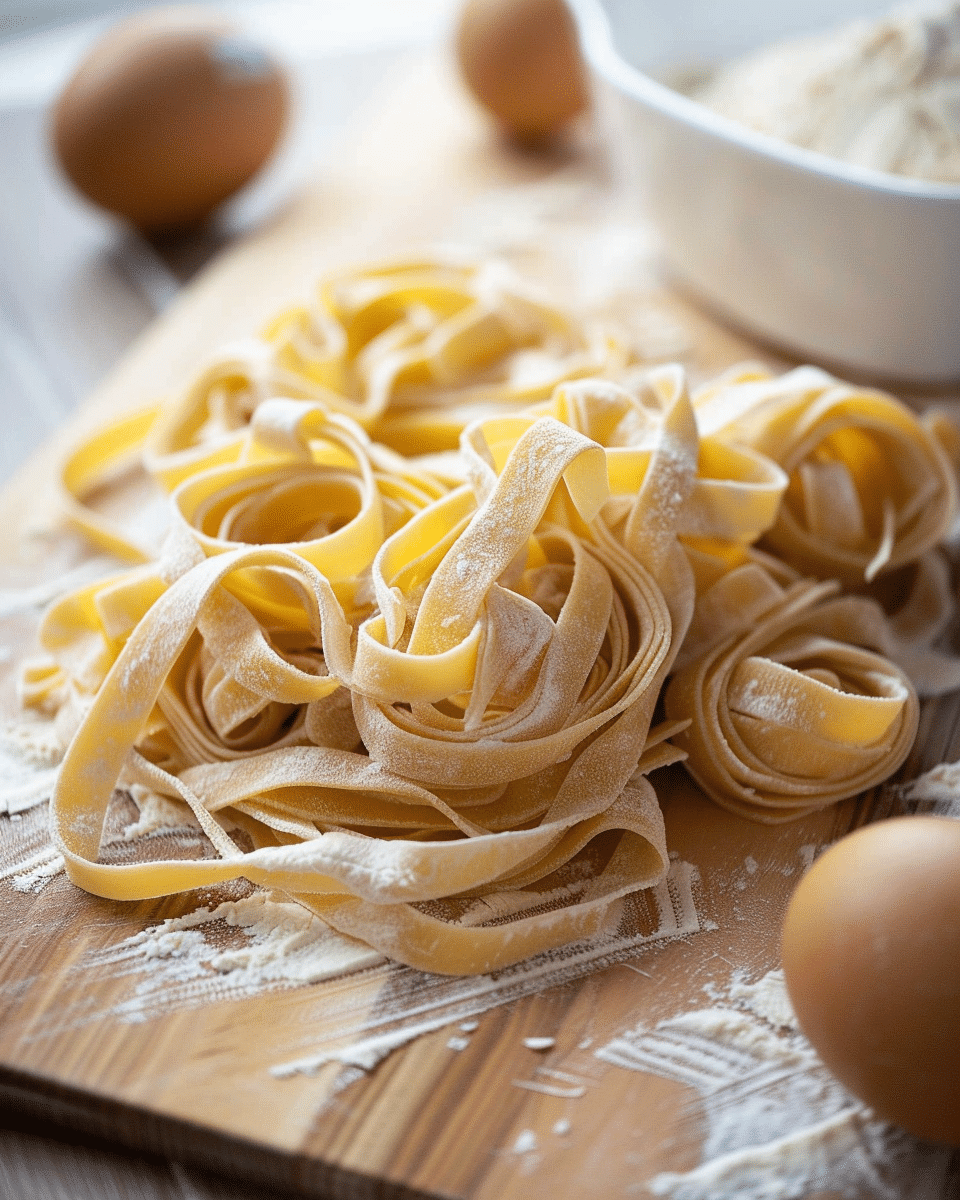Why You’ll Love This Recipe
Homemade egg pasta is a fundamental skill that opens up endless possibilities for your cooking. The rich flavor and texture of fresh pasta are unmatched, and the process is surprisingly simple. It’s a satisfying hands-on project that yields delicious results, making it perfect for everything from a casual weeknight dinner to an impressive special-occasion meal. Once you’ve mastered this dough, you’ll find endless ways to enjoy it—whether in classic dishes like Cacio e Pepe, in hearty lasagna, or in delicate ravioli.
Ingredients
- All-Purpose Flour: 2 cups (10 oz / 283g) – For a chewier, more traditional pasta, use “00” flour (doppio zero).
- Large Eggs: 3 – Farm-fresh eggs with deep orange yolks will give your pasta a beautiful golden color.
- Water: 1 tbsp – You may need a little more or less depending on the humidity and your flour.
- Extra Virgin Olive Oil: 1 tbsp – Adds flavor and makes the dough more pliable.
(Tip: You’ll find the full list of ingredients and measurements in the recipe card below.)

Directions
- Form the Flour Volcano
There are two ways to start your dough: the traditional way or the food processor way. For the traditional method, pour the flour onto a clean work surface and create a large well in the center, like a volcano. In a small bowl, whisk together the eggs, water, and olive oil. Pour this egg mixture into the center of the flour well. - Bring the Dough Together
Using a fork, gently begin to whisk the eggs in the center, gradually incorporating flour from the inner walls of the volcano. Continue until the liquid is mostly absorbed, and a shaggy dough begins to form. Once it’s too thick to use a fork, use your hands or a bench scraper to bring the remaining flour into the center and form a cohesive ball of dough.
(Food Processor Method: Combine flour, eggs, water, and oil in the bowl of a food processor. Pulse until the mixture resembles coarse crumbs. Turn the mixture out onto a work surface and press it together to form a ball.) - Knead to Silky Smoothness
Lightly flour your work surface. Knead the dough by pressing the heel of your hand into it, pushing away from you, then folding the dough back over itself. Give the dough a quarter turn and repeat. Continue this process for 8-10 minutes. The dough is ready when it is smooth, elastic, and springs back slowly when you poke it. It should feel firm and silky, not sticky. - Let the Dough Rest
Wrap the ball of dough tightly in plastic wrap or place it in a sealed bag. Let the dough rest at room temperature for at least 30 minutes, but up to 2 hours. This resting period allows the gluten to relax, making the dough much easier to roll out. - Roll and Cut Your Pasta
Once rested, unwrap the dough and cut it into four equal pieces. Work with one piece at a time, keeping the others wrapped to prevent them from drying out. Lightly flour your work surface and rolling pin. Begin to roll out the dough, starting from the center and rolling outwards, turning the dough a quarter turn after each roll. Continue until you have a very thin sheet of pasta (you should almost be able to see your hand through it). From here, you can cut it into your desired shape: fettuccine, pappardelle, or use it for ravioli or lasagna.
Servings and Timing
- Servings: 4
- Prep time: 20-25 minutes (for mixing and kneading)
- Resting time: 30 minutes (minimum)
- Total time: Approximately 1 hour
Variations
- Whole Wheat Pasta: For a heartier, more fibrous pasta, substitute half of the all-purpose flour with whole wheat flour. You may need an extra splash of water as whole wheat flour is more absorbent.
- Spinach Pasta: Blanch a large handful of fresh spinach, squeeze out excess water, and blend it with the eggs before mixing with the flour to make green pasta.
- Gluten-Free Pasta: Using a gluten-free flour blend, you can create gluten-free pasta, though it may require a bit more work. Some blends contain xanthan gum, which helps mimic the elasticity of gluten.
Sensational Serving Suggestions
- Classic Butter and Sage: Brown some butter and cook fresh sage leaves for a rich, simple sauce to toss your pasta in.
- Cacio e Pepe: Toss the cooked pasta with freshly cracked black pepper, Pecorino Romano cheese, and a little starchy pasta water for a classic Roman dish.
- Pesto: Fresh pasta is perfect for clinging to vibrant, homemade basil pesto.
- Tomato Sauce: A light, fresh tomato and basil sauce allows the flavor of the egg pasta to shine.
Common Mistakes to Avoid for Perfect Pasta
- Not Kneading Enough: Under-kneaded dough will be tough and hard to roll out. Knead for the full 8-10 minutes to develop smooth, elastic dough.
- Dough Too Wet or Too Dry: The perfect dough should be firm and not sticky. If it’s too sticky, add flour one tablespoon at a time. If it’s too dry and crumbly, add water ½ teaspoon at a time.
- Skipping the Resting Period: Resting the dough is crucial! If skipped, the dough will be difficult to roll out and will snap back.
- Not Using Enough Flour: Always lightly flour your work surface, dough, and rolling pin to prevent sticking.
Storing Your Fresh Pasta
- Short-Term (A Few Hours): Dust the cut pasta nests with flour, cover with a clean kitchen towel, and leave them at room temperature for a few hours.
- Refrigeration: Dust pasta with flour, arrange in a single layer on a baking sheet, and refrigerate for up to 2 days.
- Freezing: Let the pasta dry for about 30 minutes, dust with flour, and freeze in freezer-safe bags for up to 2 months. Cook directly from frozen, adding an extra minute or two to the cooking time.
Frequently Asked Questions
Do I need a pasta machine to make this?
No, you can easily roll the dough by hand with a large rolling pin. It’s a great workout and adds authenticity to the process!
Why is my pasta dough tough?
Tough pasta is usually due to not kneading the dough enough or skipping the resting period. Both steps are crucial for achieving a smooth, pliable dough.
How do I cook fresh pasta?
Fresh pasta cooks much faster than dried pasta. Bring a large pot of salted water to a rolling boil, add the pasta, and cook for just 2-4 minutes, or until it floats to the top and is tender.
Conclusion
Homemade egg pasta is an essential skill for any home cook, and this recipe simplifies the process without compromising on taste. With just a few basic ingredients, you can create fresh, silky pasta that transforms any meal into something special. Once you’ve mastered the technique, you’ll be able to customize your pasta to your liking and pair it with your favorite sauces. Enjoy the rewarding process of making pasta from scratch, and share your favorite pasta shapes and creations in the comments below!

The Ultimate Guide to Homemade Egg Pasta Dough
- Prep Time: 20-25 minutes (for mixing and kneading)
- Total Time: Approximately 1 hour
- Yield: 4 servings
- Category: Main Course
- Method: Homemade, Hand-rolled
- Cuisine: Italian
- Diet: Vegetarian
Description
This Homemade Egg Pasta Dough recipe is your go-to guide for making fresh, silky pasta from scratch. With just four ingredients, you’ll be able to create tender, delicious noodles that are perfect for any Italian dish. Learn how to master this essential kitchen skill with easy-to-follow steps.
Ingredients
All-Purpose Flour: 2 cups (10 oz / 283g) – For a chewier, more traditional pasta, use “00” flour (doppio zero).
Large Eggs: 3 – Farm-fresh eggs with deep orange yolks will give your pasta a beautiful golden color.
Water: 1 tbsp – You may need a little more or less depending on the humidity and your flour.
Extra Virgin Olive Oil: 1 tbsp – Adds flavor and makes the dough more pliable.
Instructions
-
Form the Flour Volcano: On a clean work surface, create a well with the flour. In a small bowl, whisk together eggs, water, and olive oil. Pour this mixture into the flour well.
-
Bring the Dough Together: Use a fork to whisk the eggs, slowly incorporating flour from the edges. Once it’s too thick for a fork, use your hands or a bench scraper to form a dough ball.
-
Knead to Silky Smoothness: On a floured surface, knead the dough for 8-10 minutes until smooth and elastic. The dough should be firm and not sticky.
-
Let the Dough Rest: Wrap the dough in plastic wrap and let it rest for at least 30 minutes at room temperature, up to 2 hours.
-
Roll and Cut Your Pasta: After resting, divide the dough into four pieces. Roll each piece out on a floured surface until it’s thin and cut it into your desired shape (e.g., fettuccine, pappardelle).
Notes
Storage: Store leftover dough in a sealed bag in the fridge for up to 2 days or freeze it for up to 3 months.
Troubleshooting: If the dough feels too sticky, add flour a tablespoon at a time. If it’s too dry, add water half a teaspoon at a time.
Making by Hand: No pasta machine? Roll the dough with a rolling pin for an authentic hand-made touch.



